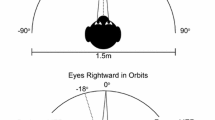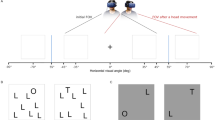Abstract.
The perception of angular head position with respect to a visual object was investigated using three different methods: Pointer indication (P); in the dark, subjects' (Ss') heads were horizontally turned to various positions (range ±54°); Ss then rotated a pointer carrying a light emitting diode (LED) so as to align it with head position. Active head pointing (A); again in darkness, the pointer was rotated to various positions; Ss then turned their heads so as to align them with the pointer. Reading from visible scale (V); Ss viewed a degrees scale on a circular screen; Ss' heads were turned as in P, and Ss reported head position in terms of this scale. The results obtained with all three methods indicate that head position is overestimated with respect to the visual object (LED, scale mark): object position exceeded head position by 6, 18, and 7% when measured with the P-, A-, and V-methods, respectively (median values). The observed misalignment between head and object suggests that subjective primary eye position is shifted in the direction of head rotation by a cross-talk of head position. Whether a functional advantage or merely a tolerated side-effect of other constraints, this behavior confers the impression of looking "straight ahead" in the literal sense when gaze is shifted by coordinated eye-head movements with a 10% eye and a 90% head share in total lateral displacement. In an attempt to probe a hypothesized internal representation of head position implied in head-to-object alignment, Ss were also to estimate head position in space using only neck proprioceptive information. In complete darkness, responses were often non-linear functions of head position with overestimation of large eccentricities. When a head-centered LED was added (which conveyed no position information), responses became more linear, suggesting that the mere presence of visual afferents may improve the perceptual interpretation of proprioceptive information.
Similar content being viewed by others
Author information
Authors and Affiliations
Additional information
Electronic Publication
Rights and permissions
About this article
Cite this article
Becker, .W., Saglam, .H. Perception of angular head position during attempted alignment with eccentric visual objects. Exp Brain Res 138, 185–192 (2001). https://doi.org/10.1007/s002210100703
Received:
Accepted:
Issue Date:
DOI: https://doi.org/10.1007/s002210100703




